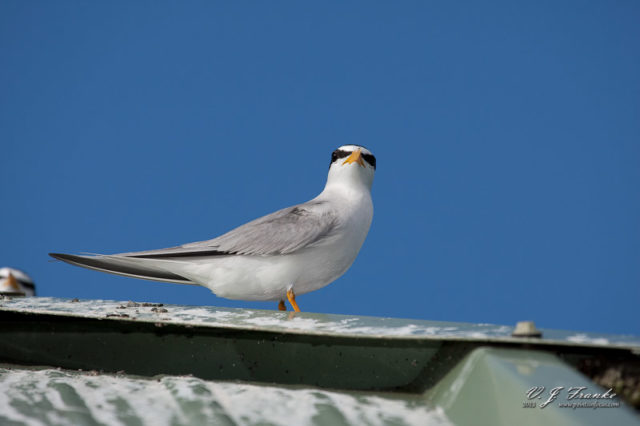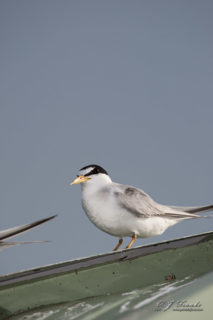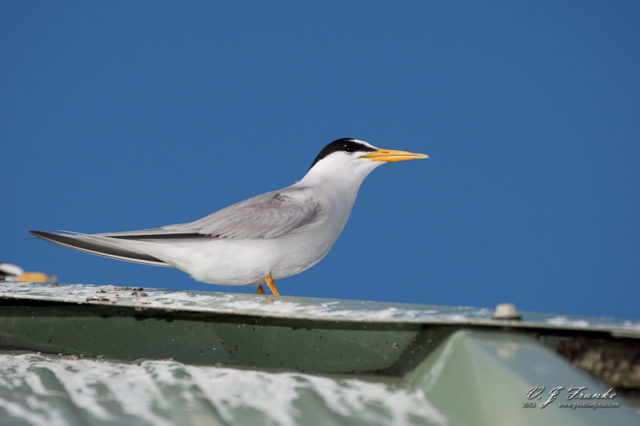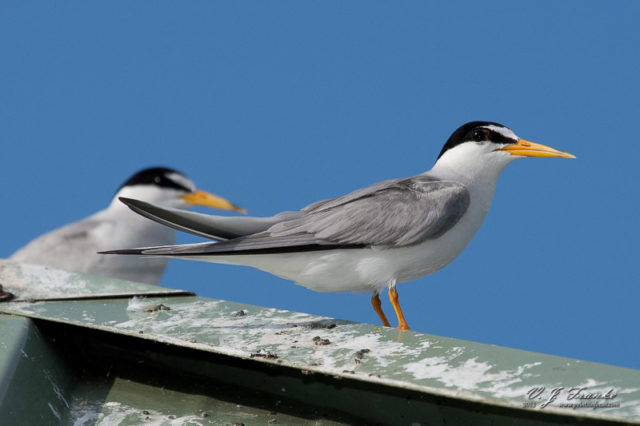Profile of the Least Tern
There are few seabirds I like better than Terns. They have clean lines, are generally approachable if you do it right, and make for great sport photographing while in flight, especially the smaller ones. In Florida several species of Terns visit us seasonally. In the winter, many of Florida’s west coast beaches, especially the less populated ones, can have sizable colonies of Royal and Sandwich Terns, among others.

However, they aren’t the only species of tern that visits south Florida. In the late spring and early summer the smallest verity of North American Terns, the Least Tern begins to appear to nest. Even better, they can be reliably found in reasonable numbers at easily accessible wetland areas like Wakodahatchee and Green Cay.
The Least Tern, Sterna antillarum, is small, growing to about 9″ from tip to tail, with a wingspan of 20″. They follow the general tern shape and have long narrow wings, a long slightly decurved tapered bill, a short tail and yellow legs.
They are easily identifiable, as the smallest white-gray tern in North America.
Adult Least Terns have white underpants, and gray upperparts and wings. All Least Tern plumage variations have a black cap, black eye-line and white forehead.
Juveniles from July to September can be identified by their brownish barring on their backs and upper wing coverts. The base of a juvenile Least Tern’s bill is flesh or yellow colored.

During their first winter, young Least Terns undergo extensive molting and develop the majority of their adult plumage, loosing the barred upperparts for solid gray. However, they retain dark patagial bar and our primaries until their first summer.
Least Terns molt into their alternate or breeding plumage during their second alternate molt. The plumage varies slightly from the adult basic plumage in several key ways. They develop a solid black cap and their eye-line extends to the base of their bill, forming a white chevron shaped forehead. The gain two dark primaries on their wings and their bills turn distinctively yellow.
Least Terns breed on open beaches, mudflats or salt flats in the summer placing them in competition with people for breeding locations. As such, Least Tern populations are declining over much of their range. The ICUN considers them as a species of least concern, however many states where they breed have consider them a threatened species.
Nests are built as scrapes in sand, soil or pebbles in areas that have little or no vegetation. There have been reports that some Least Terns colonies in some Florida counties have adapted to diminishing habitat by building nests on gravel rooftops. In most areas, nest building begins in late may and is completed by mid June.
Least Terns typically lay a single clutch of two to three eggs, but may lay a second clutch if the first one is lost. Late season clutches (relays and late arriving birds) tend to be smaller than early season clutches. Both Least Tern parents incubate the nest during the approximately 3 week long incubation period.
Least tern chicks are semi-precocial, meaning they have features including open eyes, down and the capacity to leave the nest but remain at or near the nest until close to adult size. Chicks are fully dependant on their parents for food until will after fledging even though they will practice fishing for several weeks after fledging. Some data may indicate that the parents continue to feed young least terns during their first migration and possibly at the wintering grounds.
Least Terns chicks and eggs are preyed on by a verity of smaller predatory mammals as well as birds such as the American Kestrel and American Crow.
Least Terns feed primarily on small fish. Their foraging behavior is either hovering and diving or skimming the surface of the water. At sites like Wakodahatchee and Green Cay they can be readily seen flying circuits around the open water areas. They often signal their intent to dive by hovering momentarily before plunging head first to the water.

Photographing least terns at Wakodahatchee and Green Cay provides opportunities for two general types of photographs; birds in flight and static shots often with terns perched on the metal roofs of the gazebos. Flight shots pose a significant challenge, as the Least Tern is small, very agile and fast. The static shots provide better access to producing close up images of the terns, though the images generally have artificial elements (the roof) in them, which is less desirable.
The size and speed of Least Terns pose contradictory challenges to photographing them in flight. Their small size demands a long focal length lens to achieve as much magnification as possible. However, their high speed requires much more available viewfinder space in order to continue to track them. A fast focusing but light hand-holdable lens in the 400mm range is probably a good place to start, I use Canon’s EF 100-400mm f/4.5-5.6L IS USM, thought the EF 400mm f/5.6L USM or EF 300mm f/4L IS USM would be good lighter alternatives. Nikon users have less choices, the AF-should consider the AF-S Nikkor 300mm f/4D IF-ED the AF-S VR Zoom-Nikkor 70-200 f/2.8G IF-ED with an AF-S Teleconverter TC-14E II may also be a workable solution.
I’ve had some success using both Canon’s consumer (EOS 40D) level and pro level (EOS 1D Mark 3) autofocus systems for flight shots. It goes with out saying that continuous servo autofocus and a fast continuous release mode is an absolute requirement for this type of shot. This is one time where you want to do everything you can to maximize your chances at getting anything.
Least Tern flight shots pose a second problem with respect to lighting. Their predominately white plumage reflects light very well resulting in a very high dynamic range subject. With out even lighting, and even supplemental lighting, the can exceed the dynamic range that even the best dSLRs can capture. A photograph of a side lit Least Tern can go from completely white on the sunny side to near black on the shadow side.
The ideal conditions for photographing Least Terns in flight are to have the sun low in the sky and a moderate but constant wind at your back. The sun behind you will provide fairly even lighting to the entire front surface of the bird, and the wind will help slow them down to something a little easier to track and photograph.

The technique I use for Least Tern flight shots is to start tracking the birds at considerable distance as they approach. This way I have time to locate the bird as well as allowing the camera to start focusing. I generally use the center autofocus point though, on the EOS 1D Mark 3 I will expand the auto focus point to the surrounding 9 assist points as well.
Currently I’m testing the use of the automatic focus point selection mode, for when the bird is close enough to really fill the frame. I would not recommend using automatic point selection mode on the 9- or 11-point consumer cameras, as the gird is too spread out and there is too much of a chance that one of the peripheral points will lock on to something undesirable.
Static shots can be done with a 200mm to 400mm lens. By following bird photography best practices, and placing yourself between the sun and the bird you can typically get a clean blue sky or gray cloud backgrounds can be easily had. I recommend using a flash to provide some fill lighting as you are typically shooting up towards the bird. I generally use a setting of -1 to -2/3rds EV on a Canon 580Ex II flash @ 105mm zoom. I don’t use a better beamer in these situations as frequently I’m too close and don’t want to overpower the subject.
Comments
Great information about the Least Tern and your photography of it. This species is one of my favorites to observe and photograph at venues on the Gulf of Mexico.